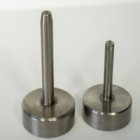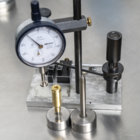Back when the Acculab Vic 123 came out I started weighing all kinds of things. After weight sorting a fresh lot of Lapua 6BR. I took to plugging them with primers that weighed the same and spent many hours filling them so as to get a good internal volume reading. What I found was that while there was no direct correlation between weight and volume. There was a strong correlation between the weight outliers and the volume outliers. So while I no longer spend all the time sorting by volume, I do sort by weight and make sure to mark all cases that do not fall into at the very least main 1% , approx 1.2gn , of the lot for non-comp use.
Eric, you may also be interested in experimenting by sorting by head thickness also. Easier to do than wall thickness. I had Chad from McCauslin Rifles make me up a couple tools back then to measure head thickness, figuring it's a good indicator also of wall thickness and how combustion and pressure build inside the case and recently got done sorting a couple boxes of Lapua brass. 100 of the fatter heads, about 20 of which are marked as sighters because of weight or head thickness, went to djsbrass to form into dashers for a 30Dasher project. The other 100, of which 21 are marked for sighters, the thinner will be turned into 30BRs. Like with weight and volume I found no real direct correlation between weight and head thickness. But when there's .007” not .07mm difference between the thick and thin heads there must also be a fairly direct correlation to differences in wall thickness and head thickness of close to the same weight cases?
You want to clamp everything down tight and even then there's a feel to it. Brass flash holes should be deburred first. Outside, I now use the Sinclair BR PPC since the newer blue box hole is bigger than the old gold box holes were. No longer like the 6BR Guide still has it, and inside with something that won't expand the hole. Think it's a Possum Hollow? The flat on the measuring tool needs to be just that, flat and larger than the primer pocket but small enough to enter the case. Not like the tapered end on a Wilson neck die de-primming mandrel. I know that the case's inside head isn't perfectly flat or even necessarily uniform. But I think the tools give a very good indication of thickness. Be interested in any ideas on how to measure it better, like a time consuming thin spindled 2" mic or thick spindled depth mic. But these give me some piece of mind.


Eric, you may also be interested in experimenting by sorting by head thickness also. Easier to do than wall thickness. I had Chad from McCauslin Rifles make me up a couple tools back then to measure head thickness, figuring it's a good indicator also of wall thickness and how combustion and pressure build inside the case and recently got done sorting a couple boxes of Lapua brass. 100 of the fatter heads, about 20 of which are marked as sighters because of weight or head thickness, went to djsbrass to form into dashers for a 30Dasher project. The other 100, of which 21 are marked for sighters, the thinner will be turned into 30BRs. Like with weight and volume I found no real direct correlation between weight and head thickness. But when there's .007” not .07mm difference between the thick and thin heads there must also be a fairly direct correlation to differences in wall thickness and head thickness of close to the same weight cases?
You want to clamp everything down tight and even then there's a feel to it. Brass flash holes should be deburred first. Outside, I now use the Sinclair BR PPC since the newer blue box hole is bigger than the old gold box holes were. No longer like the 6BR Guide still has it, and inside with something that won't expand the hole. Think it's a Possum Hollow? The flat on the measuring tool needs to be just that, flat and larger than the primer pocket but small enough to enter the case. Not like the tapered end on a Wilson neck die de-primming mandrel. I know that the case's inside head isn't perfectly flat or even necessarily uniform. But I think the tools give a very good indication of thickness. Be interested in any ideas on how to measure it better, like a time consuming thin spindled 2" mic or thick spindled depth mic. But these give me some piece of mind.


Last edited:











